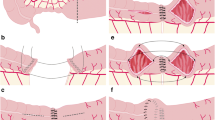Abstract
Background
The benefit of endoscopic full-thickness resection is the improved diagnostic work-up with an integral wall specimen which allows a precise determination of the tumor or its precursor and its infiltration depth into the wall.
Materials and methods
A new endoscopic full-thickness resection device (FTRD), which is a combination of a modified over-the-scope-clip (OTSC) system with an electrocautery snare, has been tested in an experimental setting. In eleven pigs, divided into three groups, endoscopic full-thickness resection was performed in the colon at one or two sites, respectively. Seven days (n = 7) or 28 days (n = 4) after the intervention, the animals were euthanized following endoscopic examination of the resection and clip application sites. Furthermore, two different clips were tested during these animal trials in order to evaluate the most effective clip design.
Results
The average diameter of the tissue resected with the FTRD was 3.1, 3.6, and 5.4 cm in the three groups. On follow-up endoscopy 7 days after the intervention, fibrin coating and stool residues were found at all clips, causing minor inflammatory reactions. However, the colon wall under the clip was non-inflamed. After 28 days, the serosa had primarily healed in all cases. There were also stool residues at all clips; however, no acute inflammatory reactions were seen anymore, due to complete healing. Histological assessment did not show any signs of dehiscence in the region of the scar, or ischemia in the clip area. In addition, no wound infections, such as abscess formation, were observed.
Conclusions
This study demonstrates the safety and efficacy of the clip-and-cut technique using the new FTRD system. With the device, a local full-thickness colon resection can be easily created, and the resulting wall defect is reliably sealed by the endoluminal application of a modified OTSC clip.








Similar content being viewed by others
References
Hachisu T (1988) Evaluation of endoscopic hemostasis using an improved clipping apparatus. Surg Endosc 2(1):13–17
Repici A, Arezzo A, De Caro G, Morino M, Pagano N, Rando G, Romeo F, Del Conte G, Danese S, Malesci A (2009) Clinical experience with a new endoscopic over-the-scope clip system for use in the GI tract. Dig Liver Dis 41(6):406–410
Weiland T, Fehlker M, Gottwald T, Schurr MO (2013) Performance of the OTSC system in the endoscopic closure of iatrogenic gastrointestinal perforations: a systematic review. Surg Endosc 27(7):2258–2274
Arezzo A, Verra M, Reddavid R, Cravero F, Bonino MA, Morino M (2012) Efficacy of the over-the-scope clip (OTSC) for treatment of colorectal postsurgical leaks and fistulas. Surg Endosc 26(11):3330–3333
Saito Y, Fukuzawa M, Matsuda T, Fukunaga S, Sakamoto T, Uraoka T, Nakajima T, Ikehara H, Fu KI, Itoi T, Fujii T (2010) Clinical outcome of endoscopic submucosal dissection versus endoscopic mucosal resection of large colorectal tumors as determined by curative resection. Surg Endosc 24(2):343–352
Brigic A, Symons NR, Faiz O, Fraser C, Clark SK, Kennedy RH (2013) A systematic review regarding the feasibility and safety of endoscopic full thickness resection (EFTR) for colonic lesions. Surg Endosc 27(10):3520–3529
Schurr MO, Buess G, Raestrup H, Arezzo A, Buerkert A, Schell C, Adams R, Banik M (2001) Full thickness resection device (FTRD) for endoluminal removal of large bowel tumours: development of the instrument and related experimental studies. Minim Invasive Ther Allied Technol 10(6):301–309
Rajan E, Gostout CJ, Burgart LJ, Leontovich ON, Knipschiel MA, Herman LJ, Norton ID (2002) First endoluminal system for transmural resection of colorectal tissue with a prototype full-thickness resection device in a porcine model. Gastrointest Endosc 55(7):915–920
Agrawal D, Chak A, Champagne BJ, Marks JM, Delaney CP (2010) Endoscopic mucosal resection with full-thickness closure for difficult polyps: a prospective clinical trial. Gastrointest Endosc 71(6):1082–1088
Raju GS, Malhotra A, Ahmed I (2009) Colonoscopic full-thickness resection of the colon in a porcine model as a prelude to endoscopic surgery of difficult colon polyps: a novel technique. Gastrointest Endosc 70(1):159–165
Sandmann M, Heike M, Faehndrich M (2011) Application of the OTSC system for the closure of fistulas, anastomosal leakages and perforations within the gastrointestinal tract. Z Gastroenterol 49(8):981–985
Picasso M, Parodi A, Fisher DA, Blanchi S, Conio M (2013) Full thickness endoscopic resection of a colonic cancer: a case report. Clin Res Hepatol Gastroenterol 37(4):e99–e101
Mönkemüller K, Peter S, Toshniwal J, Popa D, Zabielski M, Stahl RD, Ramesh J, Wilcox CM (2014) Multipurpose use of the ‘bear claw’ (over-the-scope-clip system) to treat endoluminal gastrointestinal disorders. Dig Endosc 26(3):350–357
Schlag C, Wilhelm D, von Delius S, Feussner H, Meining A (2013) EndoResect study: endoscopic full-thickness resection of gastric subepithelial tumors. Endoscopy 45(1):4–11
von Renteln D, Kratt T, Rösch T, Denzer UW, Schachschal G (2011) Endoscopic full-thickness resection in the colon by using a clip-and-cut technique: an animal study. Gastrointest Endosc 74(5):1108–1114
Hope WW, Zerey M, Schmelzer TM, Newcomb WL, Paton BL, Heath JJ, Peindl RD, Norton HJ, Lincourt AE, Heniford BT, Gersin KS (2009) A comparison of gastrojejunal anastomoses with or without buttressing in a porcine model. Surg Endosc 23(4):800–807
Nandakumar G, Richards BG, Trencheva K, Dakin G (2010) Surgical adhesive increases burst pressure and seals leaks in stapled gastrojejunostomy. Surg Obes Relat Dis 6(5):498–501
Disclosures
Marc O. Schurr and Thomas Gottwald hold senior management positions for Ovesco Endoscopy AG. Franziska E. Baur is head of product manager of Ovesco Endoscopy AG. Manfred Wehrmann has no conflicts of interest or financial ties to disclose. Ruediger L. Prosst, Martina Krautwald, and Marion Fehlker are medical consultants of novineon CRO which advises Ovesco Endoscopy AG in regulatory and product development affairs.
Author information
Authors and Affiliations
Corresponding author
Rights and permissions
About this article
Cite this article
Schurr, M.O., Baur, F.E., Krautwald, M. et al. Endoscopic full-thickness resection and clip defect closure in the colon with the new FTRD system: experimental study. Surg Endosc 29, 2434–2441 (2015). https://doi.org/10.1007/s00464-014-3923-x
Received:
Accepted:
Published:
Issue Date:
DOI: https://doi.org/10.1007/s00464-014-3923-x




